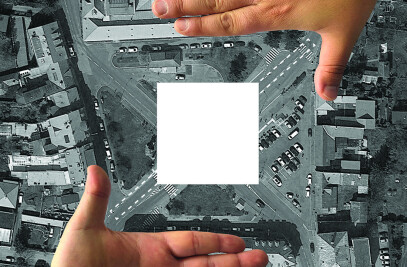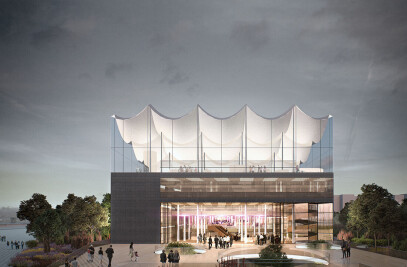Team: Irgen Salianji, Marina Kounavi, Karolina Szóstkiewicz, Fouad Addou, Stavria Psomiadi
Total Area: 85.000 m2 Parking Spots: 2.300 Client: Bibliotheca Alexandrina & UIA Status: Competition Project
Urban realm The 6th of October city is a satellite city that is built in 1979 in order to cover the housing demand of Cairo. It is located 17 km from the Great Pyramids of Giza and 32 km from the city of Cairo and it consists of a desert city. The cultural context and the site on the one hand impose challenges and difficulties, and on the other hand they offer large opportunities for intervention development. Egypt has been since ancient times a country with a leading role in the development of sciences and production of intellect. There is therefore plenty of inspiration that could lead in the formation of an architectural project for the Science City. The urban realm is characterized by introvert residential complexes, private recreational and educational institutions and other local industries. The multifunctional character of the site creates a real challenge as it is not part of a specific historical context but it is a generic urban structure in process, aiming to cover needs of the continuously increasing size of the city. The site is exploited by private investments and lack of architectural harmony. The privatization of the land and the lack of public facilities decrease the urbanity of the wider context, namely the livingness of a city and continuous flow of people. The design of the master plan should aim to provide a new pubic democratic space that is flexible for future transformations, by being extrovert and promoting the potentials of a continuous and vivid landscape. On this context, the Science City acts as a node and an incubator, by containing as its main ingredients the solid architecture expression and the diverse landscape. Concept The building follows the organization of a city based on a clear orthogonal grid that is prominent in the scheme but not absolute, in order to create space for diversity in scale and function. The city is the result of the composition of different metropolitan and architectural elements such as the urban grid, the block, the street and the landmark. Follows such principles of composition, the Science City introduces the street as the connection between inside and outside. The accumulation of different volumes that contain different program and the interconnection of them with a path system that is expanded into the science park are the main elements that consists both the master-plan and the building circulations of the science city. The main path system is flexible and (re) defined by the three phases that the building will follow. Moreover the idea of the city is enhanced with the development of multifunctional floor plans that lead to a diversity of solutions and to the generation of unexpected situations for the visitors. Blending density, educational and recreational functions, exhibitions and landscape patterns, the ground floor is an open laboratory of life, science, art and curiosity. Organization The building is divided in three, the phase I containing the main core of services and the the orientation hall. The distribution of the functions is arranged in program rings, therefore the campus can contain 40% of all programmatic elements in Phase I, 30% in Phase II and 30% in Phase III. The element of the street is introducing the visitors to the orientation hall. The volume is perforated by courtyards, resulting to a stronger relationship with the science park. The interactive temporary exhibition is located on the ground floor with direct connection to the science park and the open-air exhibition areas. Also on the ground floor the visitors can find the HD theater, the observatory tower base etc. Also most of the technical services are located on the ground floor. The first floor is defined by a programmatic ring of the research at the perimeter of the volume and a core of the permanent exhibition. Art and scientific research are in constant interaction. The third and last floor is even more perforating than the other two leading to a dissolve of the city. The floor plan is structured by a ring of administration with a core of workshops and the conference center.
- Science park- Concept The science park is characterized by an interweaving pattern of paths and an accumulation of programmatic rooms reminding of the cabinet of curiosities- kunstkammer that appeared at 16th century with the establishment of the first collections of natural history and art. The kunstkammer is regarded as a theater of the world- a microcosm. The intention of the science park is to educate the visitors on different scientific fields and underline the unique landscape of Egypt. Fusing inside and outside by means of design and program continuity, the paths of the park enter into the exhibition spaces and fragment the building into several interconnected spaces, thus creating views and escapes into the landscape, at the same time proclaiming potentials for future expansions. - Science park- Structure The pattern of the master plan is defined programmatically by two main themes- the dryness and the moisture- the desert and the water or in accordance with the Egyptian mythology Tefnut and Shu- that define the landscape of Egypt. The road of the desert and the road of the water are the main elements that split the building creating courtyards, patterns on the desert, escapes to the landscape and possibility for infinite future expansion. The two main axes serve a double role, on the one hand providing the main entrances to the building and on the other hand fragmenting it into three phases. The phasing character of the project is therefore based on the notion of continuity, namely three separate buildings that when put together form a unified and continuous entity. The repetition of intersecting corridors and the variation of the scale of the roads define different programmatic rooms both inside the building and outside in the Science Park. Consequently, the Science Park provides different experiences that are about both the immediate and the wider range of sciences, such as natural phenomena-elements and Egyptian landscapes, maths, the stars, wind, energy, the agriculture, the land formation, the gardening, the flora of Fiona of Egypt. Hardscape The path system is consisted by a mixture of Egyptian sandstone that is similar with the Tura stone used for the Pyramids. The selection is aiming to the harmonious integration of the Science Park in the landscape. The path system is enhanced with seating areas and art. Softscape The main species that are dominant in the park are different indigenous palm trees such as date and doum palm that illustrates the path system and at the same time provide shade. Acacia, pomegranates and ficus sycomorus are other trees that are planted in the exhibition gardens and the courtyards. Water basins accumulate the water from the building creating water canals on the landscape and small oasis on the desert site. The planting that is suggested on that areas is palm and banana trees and shrubs like netumbo nucifera, nymphea caerulea, papyrus and persea indica. Final, indigenous desert species fulfill the planting of the science park.

































